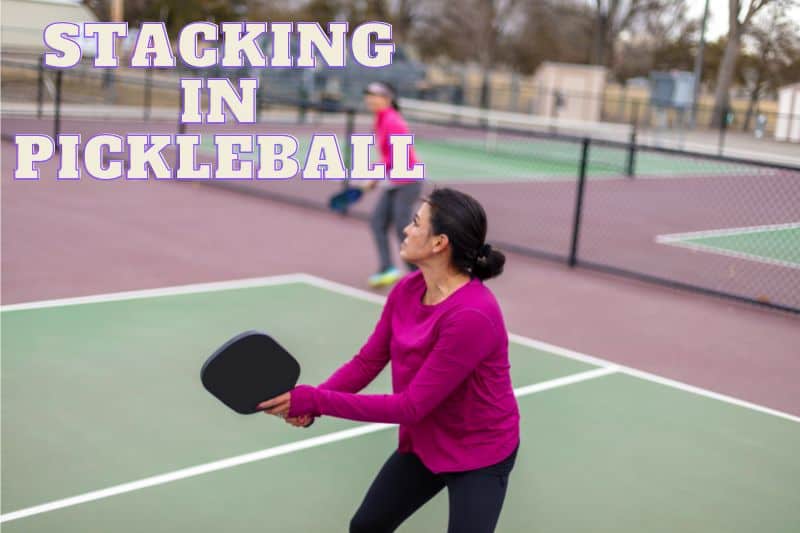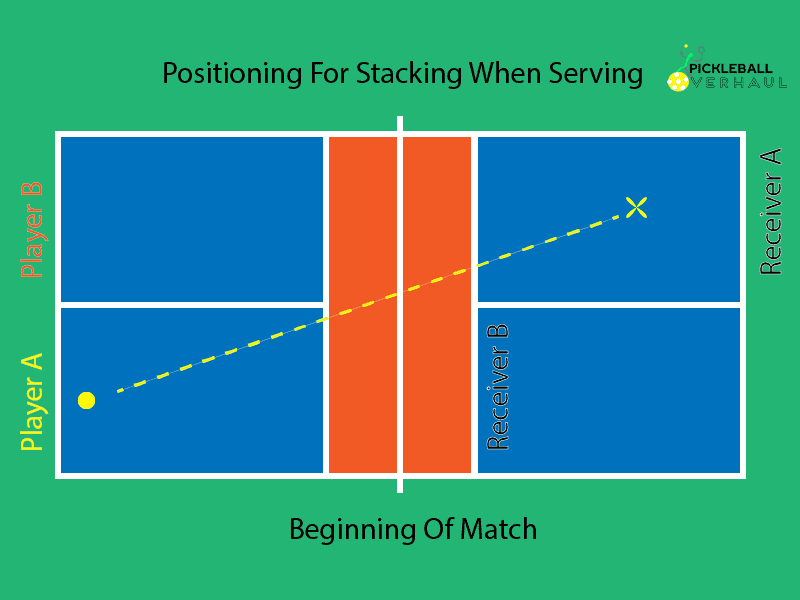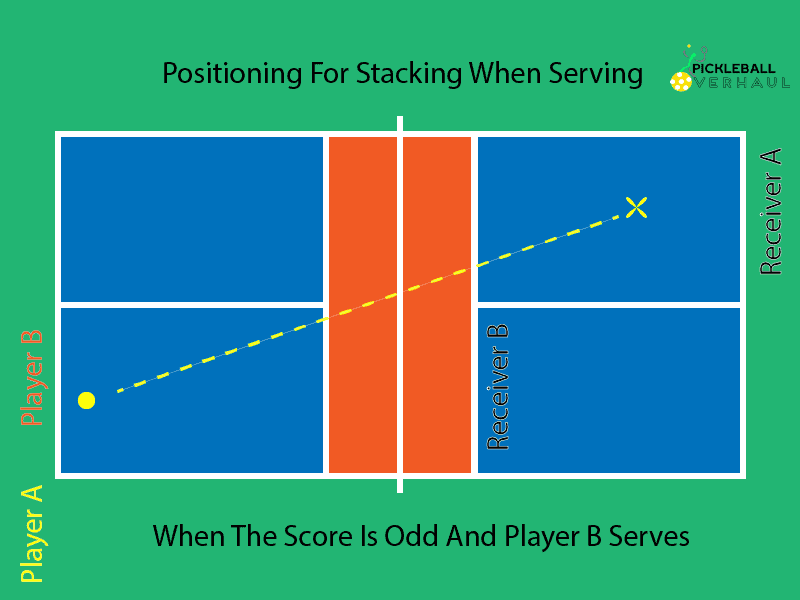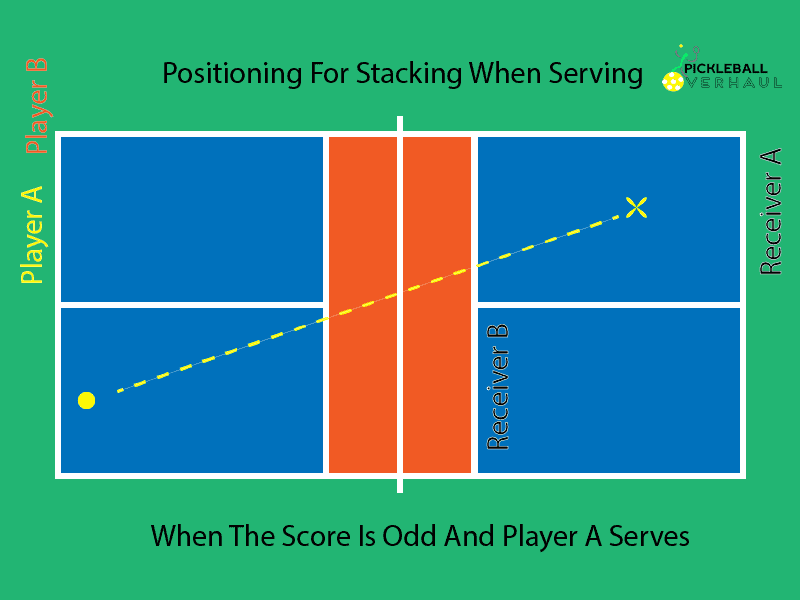
You will hear about stacking if you’re interested in playing in pickleball tournaments or moving up to higher-level plays. But stacking can bring a lot of confusion for both the teams that are using stacking and for their opponents. Here is your complete guide to stacking in pickleball, including how to stack, different ways to stack, and why it is used in competitive play.
What Is Stacking In Pickleball?
When someone brings up the concept of stacking for the first time, the question is always what is stacking or how stacking works in pickleball. Stacking is simply positioning the two players on the sides of the court to play where they’re strongest, no matter what the score is. The strategy behind stacking is that you want to put the strongest forehand in the middle.
Traditionally, two players switch sides every time they score a point. However, when the players use stacking, Player A and Player B will always assume the same side of the court after they serve. The rules for the position where each player must make their service remains the same.
For example, Player A and Player B will stack where Player A will play on the right side while Player B plays on the left side. Player A will serve first and when the team wins the point, Player A will serve from the left side. However, as soon as Player A finishes the service, Player A will scoot to cover the right side.
But what about Player B when Player A serves from the left side of the court? They will simply stay on the left side of Player A until they finish the service and slide toward their side of the court.
The same concept applies when Player B has to serve from the right side of the court. Player A will remain on the right side of Player B until Player B finishes the serve and slides to the left side of the court.
Types Of Stacking
There are two types of stacking in pickleball: a full stack and a half stack. Let’s go over them.
Full Stacking

Full stacking is when two players always play on the same side of the court, whether the team is serving the ball or receiving it. And whether the score is even or odd. The players must serve and receive on the side that they’re supposed to as per the pickleball rule. But they will move toward their side of the court after serving or returning the ball.
So if Player B is stacking on the left but serves from the right side, Player A will stand on Player B’s right side. They will both then slide over to the left.

Similarly, if Player A that plays on the right side has to serve from the left side of the court, Player B will stand on Player A’s left side. And they will both slide right once Player A finishes the serve.

Half Stacking
Half stacking is only using stacking when the team is serving. If the team sides out when the two players are supposed to be on opposite sides of the stack, they remain that way for receiving.
So why would a team want to use only half-stacking? Because half stacking is easier to understand for a lot of people when they first start using stacking. It is easy for both players to slide toward their own side of the court as soon as the server completes the serve.
However, when you stack while receiving, it can cause confusion about which player is supposed to receive the service. On odd scores, Player B would be receiving the service on the right side of the court while Player A would be receiving it on the left side.
Since this is the opposite way of how Player A and Player B stack, they would have to swap positions as soon as the person receiving the serve returns it. It is a lot more effort to do this.
While this is not a big deal in a rec game and most people would allow a redo, it can cost you a point in tournaments.
That is why the pros will ask the referee if the correct player is serving from the correct spot. And you should too if you’re interested in stacking with your partner to play in a pickleball tournament.
Unwinding The Stack
You may hear of the term unwinding the stack in pickleball. Unwinding the stack simply means to get play in the position that each player is supposed to without stacking. So if Player A is supposed to play the left side for that point, even though they’re supposed to
Why Should You Use Stacking?
So should you be using stacking? If so, what are the advantages and disadvantages?
Advantages Of Stacking
There are many reasons for using stacking in pickleball with the most significant advantage being that you’re protecting the middle of the court with the team’s strongest shot, which is traditionally the best player’s forehand.
That is why you will often see mixed doubles teams stack in tournaments. The male partner will usually play on the left side while the female partner plays on the right side. You want the strongest shot, which is traditionally the male player’s forehand, to be in the middle.
At lower levels, some players may also not be great at or comfortable using their backhand. In that case, you would want them to play on the right side so their backhand is covered by their partner’s forehand.
If you’re a right-handed player playing with a left-handed partner, you would want to place your partner on the right side of the court while you take the left side of the court. This would allow both of your forehands to be in the middle to cover the middle of the court.
The middle of the court is especially important to cover because that is the high-percentage shot where your opponents would most likely hit rather than the sidelines.
Disadvantages of Stacking
The main disadvantage of stacking is that it can be confusing for some people. It can cost you a point in tournaments when you don’t keep track of your positioning based on your score. If you’re also always playing one side, whether it is a rec game or a tournament, you may be in the habit of not developing your backhand.
More Pickleball Tips
Read Next: Best Pickleball Shots That Finishes The Point
Read Also: How To Be A Good Pickleball Partner
Recommended Outdoor Pickleballs: Franklin X-40 Pickleball Balls
Recommended Indoor Pickleballs: Onix Pure 2 Indoor Pickleball Balls

